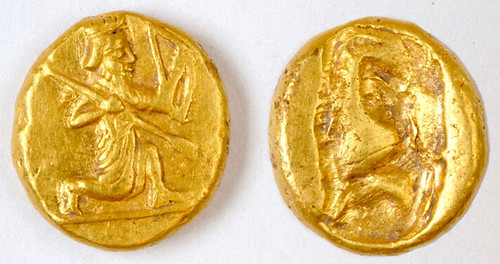
PREV ARTICLE
NEXT ARTICLE
FULL ISSUE
PREV FULL ISSUE
PERSIAN GOLD COINS FOUND IN TURKEYUniversity of Michigan archaeologists found a hoard of Persian gold coins in western Turkey. -Editor A team of researchers led by a University of Michigan archaeologist has uncovered a hoard of gold coins, likely used to pay mercenary troops, buried in a small pot in the ancient Greek city of Notion in western Turkey. The coins show a figure of a kneeling archer, the characteristic design of the Persian daric, a type of gold coin issued by the Persian Empire and probably minted at Sardis, 60 miles northeast of Notion, said U-M archaeologist Christopher Ratté, professor of classical studies, curator of the Kelsey Museum of Archaeology and director of the Notion Archaeological Project, the project that discovered the coins. The hoard, which the U-M team dated to the fifth century B.C., will provide another datapoint that can tell historians about the Persian daric's timeline and history. Darics were minted from the late sixth century B.C. until the conquest of the Persian empire by Alexander the Great in 330 B.C., and the design of the coins remained the same with only minor stylistic differences. Researchers have tried to arrange the coins in a chronological sequence by analyzing those stylistic differences. One of the important aspects of the newly discovered hoard is that it is independently dated by other artifacts associated with the hoard. "This hoard will provide a firm date that can serve as an anchor to help fix the chronology of the (entire sequence of coins)," Ratté said. According to Andrew Meadows of Oxford University, formerly curator of coins at the British Museum and the American Numismatic Society, the archaeological context for the hoard is likely "if it can be established accurately by other means, to allow us to fine-tune the chronology of the Achaemenid gold coinage. This is a spectacular find … of the highest importance."
To read the complete article, see:
Pablo Hoffman passed along a New York Times article on the find. Thanks. -Editor It is the late fifth century B.C. and a mercenary soldier kneels in his modest quarters, digging a hole in the earthen floor. He places a small jug, called an olpe, in the hole for safekeeping and covers it with dirt. In the olpe are his savings — scores of gold coins, known as darics, each one equal to a month's pay. But something happens to the soldier — possibly something sinister — and he never retrieves his hoard, which remains undiscovered for the next 2,400 years. That is one of several scenarios proposed by Christopher Ratté, an archaeologist at the University of Michigan, to account for the cache, which he and his research team recently unearthed from the ruins of Notion, an ancient city-state in modern-day Turkey. While digging beneath the courtyard of a house dating to the third century B.C., the excavators found the remains of an earlier dwelling. "The coins were buried in a corner of the older building," Dr. Ratté said. "We weren't actually looking for a pot of gold."
To read the complete article, see:
Wayne Homren, Editor The Numismatic Bibliomania Society is a non-profit organization promoting numismatic literature. See our web site at coinbooks.org. To submit items for publication in The E-Sylum, write to the Editor at this address: whomren@gmail.com To subscribe go to: https://my.binhost.com/lists/listinfo/esylum All Rights Reserved. NBS Home Page Contact the NBS webmaster 
|
